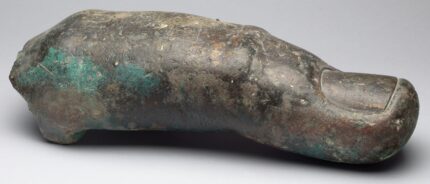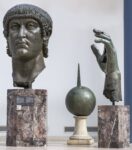 The bronze colossus of Constantine in Rome’s Capitoline Museums has been reunited with his long-lost finger. The missing piece is a section 15 inches long comprising the top two phalanges of the left index finger. It was rediscovered in the collection of the Louvre in 2018 by Aurélia Azéma, a doctoral student researching ancient welding techniques used to create large-scale bronze statues. It had been mistakenly catalogued as a Roman toe, but Azéma realized it was a finger and calculated from its dimensions that it would fit a statue 40 feet in height. That’s a very short list, and the bronze Constantine, along with its marble acrolith counterpart also in the Capitoline Museums, are the only surviving pieces of ancient statues that size.
The bronze colossus of Constantine in Rome’s Capitoline Museums has been reunited with his long-lost finger. The missing piece is a section 15 inches long comprising the top two phalanges of the left index finger. It was rediscovered in the collection of the Louvre in 2018 by Aurélia Azéma, a doctoral student researching ancient welding techniques used to create large-scale bronze statues. It had been mistakenly catalogued as a Roman toe, but Azéma realized it was a finger and calculated from its dimensions that it would fit a statue 40 feet in height. That’s a very short list, and the bronze Constantine, along with its marble acrolith counterpart also in the Capitoline Museums, are the only surviving pieces of ancient statues that size.
 The colossus in its current form dates to the early 4th century (the head may originally have been cast as far back as the 1st century and then been recarved to depict subsequent emperors with Constantine as the last). Nothing is known about its fate in late antiquity and the early Middle Ages. It emerges again in the 12th century, part of the papal collection. The head, the hand, a partial forearm and a sphere topped with a pointed spine, were installed in the courtyard of the Lateran
The colossus in its current form dates to the early 4th century (the head may originally have been cast as far back as the 1st century and then been recarved to depict subsequent emperors with Constantine as the last). Nothing is known about its fate in late antiquity and the early Middle Ages. It emerges again in the 12th century, part of the papal collection. The head, the hand, a partial forearm and a sphere topped with a pointed spine, were installed in the courtyard of the Lateran
The head was described as bearing a gilded crown, now lost, although significant traces of gilding survive on the extant fragments of the bronze.  The globe was held in the giant hand, a symbol of imperial power, and a small statue, perhaps of victory is believed to have been mounted atop the spine. The sphere was still in the hand as late as 1465. The group was donated to the People of Rome in 1471 by avid patron of the arts and collector of antiquities Pope Sixtus IV, but sometime between then and the 1584, the sphere was detached from the hand and mounted on the first milestone of the Appian Way.
The globe was held in the giant hand, a symbol of imperial power, and a small statue, perhaps of victory is believed to have been mounted atop the spine. The sphere was still in the hand as late as 1465. The group was donated to the People of Rome in 1471 by avid patron of the arts and collector of antiquities Pope Sixtus IV, but sometime between then and the 1584, the sphere was detached from the hand and mounted on the first milestone of the Appian Way.
 A part of the palm is missing from when the sphere was detached. It’s likely the index finger was amputated around this time as well, as descriptions written shortly after the unfortunate operation note the upper two phalanges missing from the index finger. There are no documentary records of it entering the Roman antiques market at this time, but someone took it out of circulation around this time.
A part of the palm is missing from when the sphere was detached. It’s likely the index finger was amputated around this time as well, as descriptions written shortly after the unfortunate operation note the upper two phalanges missing from the index finger. There are no documentary records of it entering the Roman antiques market at this time, but someone took it out of circulation around this time.
The finger fragment disappears from the historical record until the 19th century. It pops up in France in 1863, part of a large acquisition by the Louvre Museum of pieces from the collection of Roman banker Marquis Giampietro Campana who amassed one of the century’s greatest collections of Roman and Greek antiquities.
 When Azéma recognized it as a finger and proposed it might have been Constantine’s, an exact replica was cast out of fiberglass. The fiberglass finger was sent to Rome where conservators tested it on the bronze hand. It was a perfect fit. Now, exactly 550 years after the Sistine donation and 500 years after it was disarticulated, the finger has been reattached to the hand and is on display in the Exedra of Marcus Aurelius in the Capitoline Museums.
When Azéma recognized it as a finger and proposed it might have been Constantine’s, an exact replica was cast out of fiberglass. The fiberglass finger was sent to Rome where conservators tested it on the bronze hand. It was a perfect fit. Now, exactly 550 years after the Sistine donation and 500 years after it was disarticulated, the finger has been reattached to the hand and is on display in the Exedra of Marcus Aurelius in the Capitoline Museums.